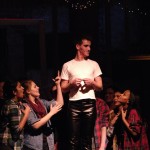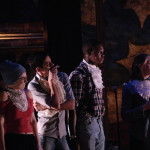Bloody Bloody Gushes into Fieldston
For any unsuspecting viewers sitting in the auditorium on the evenings of February 28th and March 1st, the dimming of the house lights was accompanied by a lively surprise. As the curtain rose, Will Conard (V) strode across the stage in “some tight, tight jeans,” followed closely by a concentrated ensemble whose energy was more than palpable. The show was Bloody Bloody Andrew Jackson, but expectations of a straight, earnest retelling of the controversial President’s heyday during the 19th century were undoubtedly subverted. Ensuring that the rest of the cast was “ready,” Conard confirmed that his pants were, in fact, quite tight, and the company launched into Bloody Bloody’s rousing opening number, “Populism Yea Yea.” By the end of that relentlessly catchy song, it appeared that the audience knew what it was in for – and was excited for it, too.
With a Broadway run in the fall of 2010, Bloody Bloody was well received by critics and theatergoers. One such attendee was Clare Mottola, who in her director’s statement noted that she “had a hunch we would do Bloody Bloody…since I first saw it on Broadway.” Indeed, her intuition proved correct – Fieldston was the first high school to perform the show. Though rehearsals began before winter break, the student body at large was alerted to Bloody Bloody via posters that appeared last month, which displayed prominent political and media figures, both living and dead, along with the tagline, “I am Andrew Jackson.” The provocative nature of the subject matter was something that alternately enticed and scared Mottola, who wrote that “[nothing] will compare to the terror I felt directing Bloody Bloody” but that its formation was “truly a journey like no other.”
Cast members corroborated this fear, but emphasized that Ms. Mottola directed the musical freely and with confidence in both the material and her actors. “Clare…made this show what it was,” said senior Rohit Gopal, who portrayed Jackson’s father and John C. Calhoun, among others. “She wanted us to take our own liberties.” Integral to that liberty was improvisation, which as Max Beer (VI) noted made up a healthy portion of the musical. Beer, who as Martin Van Buren had one of the most riotous moments of the show in a wholly improvised monologue to Conard’s Jackson that alternately involved a Bahamas getaway (Friday night) and a Disney cruise (Saturday night), noted that trial and error was crucial to the process: “I can’t tell you how many times I embarrassed myself during the rehearsal process…[but] those failures are what every actor needs to create the best possible character.”
The spontaneous humor drawn from that unscripted feel helped to loosen up the historical sequences in Bloody Bloody, which paints Jackson as a normal guy with an abnormal thirst for power as it tracks him from birth to his military service, eventual presidency and subsequent enforcement of the Indian Removal Act, before concluding with moral self-questioning in his later years. Comedy works not only to contrast the dark themes, but to enhance the way we look at a dark period in our history that is often written off as successful. The laughs here are barbed, and because they are delivered by such a talented ensemble, stick to the ribs. Scenes in which Jackson negotiates with his Native American liaison Blackfox (junior Sasha Hixson) are graced with levity from nimble performances by Conard and Hixson. Skillful turns from Gopal, Beer, Arianna Ruiz, Jayson Pugh (as White House tour takers), and an excellent Martha Epstein (VI) as both a tourist and Jackson’s wife, Rachel, also add to the clever casting. Near the middle of Bloody Bloody, Sophie Moss Slavin (VI) expertly toes the line between tragedy and tongue-in-cheek farce during “Ten Little Indians.”
The comparative smallness of the ensemble in Bloody Bloody has no effect on the vigor it brings to the stage. Though there is hardly a sequence devoid of his swaggering presence, Conard stressed the communal nature of the project. “This really is an ensemble show. I do not believe that there is a single person who worked harder than anyone else…the bravery and passion that every single member of the cast and crew showed really allowed us to bring the show to its final point,” he said. The band, comprised of faculty member William Norman, Marcelo Rivera (VI) on guitar, and sophomores Lucky Lai on bass and Kolbein Finsnes on drums, is always visible and repeatedly included in the proceedings.
As for Conard himself, scenes that require his sole presence onstage feel just as full as those that incorporate the entire company. He effortlessly transitions from machismo to genuine sorrow, enforcing the moral grey area that Bloody Bloody lives in. Marital exchanges between him and Epstein, as Rachel, serve as an emotional core of sorts for the show. Senior Kate Rosenberg provides the same sentiment in a number lamenting Jackson’s shortcomings and transgressions against the Indians later in the show. Even when the book, by Alex Timbers, is stumbling over itself to cram in as much history as possible or to ratchet up the irreverence, Ms. Mottola and her performers ensure that we have something to hold on to.
The rapid character changes were not seen as a burden, but rather a reward. “It not only challenged me as an actor, it also made the experience so much more interesting. When you are rehearsing the same show for months it can start to feel tedious, but in a show where you are playing so many different characters, it is always exciting and fun,” said Truly Siskind-Weiss (V) who herself embodied everything from an airhead cheerleader to a contentious Spaniard. “It also allowed everyone in the cast to have an important role.”
Fieldston has a history of putting on shows that provoke in both content and theme, but what sets Bloody Bloody apart is context. A show that entertains and opens eyes simultaneously is not an everyday occurrence, and for all the faults of a book that is sometimes too smart for its own good, this one is particularly important. Seeing it performed by students who may very well be learning the material in a history class lends an additionally interesting perspective to the production. From thoughtful direction to exemplary work behind the scenes, and the dedicated work of an exciting ensemble, Bloody Bloody marks a fascinating change of pace for Fieldston theatre.








